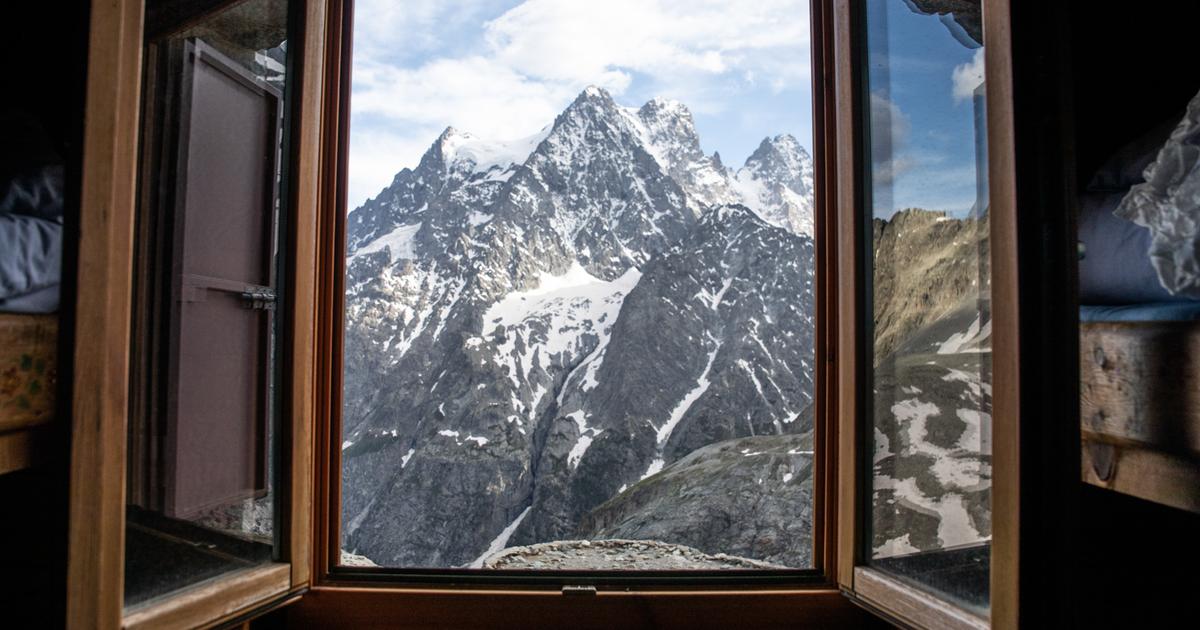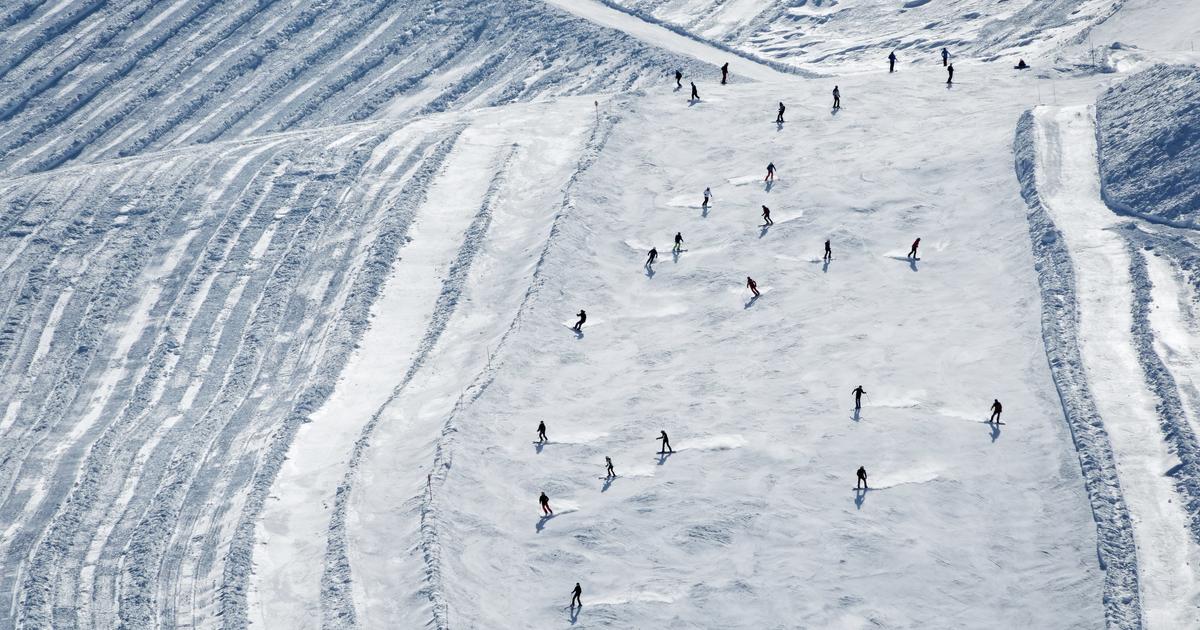Little time? At the end of the text there is a summary.
Fabrizio Troilo just returned from a flight over the crisis area. He used a helicopter to circle the Planpinceux massif on Wednesday mornings. It was snowing and that was good. Maybe you will get away with it again.
Troilo is a member of the Fondazione Montagna Sicura in Courmayeur, Italy. The Aosta Valley Foundation deals with mountain safety in the Italian-French border area around Mont Blanc, Europe's highest peak. And there threaten to break off parts of a glacier and plunge to the valley. In total, it is about 250,000 cubic meters of ice.
"We have seen a smaller ice avalanche," says Troilo the SPIEGEL. Maybe that's a sign that not the entire package is slipping at once. "It could be good if it all comes down to smaller portions." That it is currently relatively cool, bring some relaxation. But it takes several frosty days at a stretch, so that some rest in the glacier come.
photo gallery
6 pictures
Alpine glacier: Climate change at work"Such phenomena show once again that the mountains are in a phase of strong change because of climatic factors - and therefore particularly vulnerable," quotes the Italian news agency Ansa the mayor of Courmayeur, Stefano Miserocchi. Fearing a possible crash on the Planpincieux, the commune has had two mountain roads in Val Ferret closed as a precaution, as well as several mountain huts. There is no danger to local residents or tourists.
Using a camera, researchers monitor the glacier's behavior from the opposite side of the valley. Niccolo de Matteis from the National Research Council of Italy in Turin leads the team. Since the end of August, the ice has moved by about 60 centimeters per day, he told the SPIEGEL. Currently, the value is about 35 to 40 centimeters. Especially dangerous is the large crack that has formed in the Eiszunge. "We can not model when the glacier collapses," says de Matteis. But 250,000 cubic meters of ice, that's already "a lot".
There have always been crashes on the Planpincieux, but this time around ten times as much ice, according to the researcher. "Certainly, climate change has an impact on these events." His colleague Troilo looks the same. He points out, among other things, that now large amounts of meltwater between the glacier and the underlying rock came. "That's definitely not helpful."
"Impressive Indicators of Current Climate Change"
On Wednesday, the Intergovernmental Panel on Climate Change (IPCC) published its special report on the world's oceans and ice zones. This is also about the dramatic disappearance of the glaciers. Ten percent of the Earth's surface is covered with glaciers and ice sheets, the report says. In recent decades, they have become smaller and smaller, they say. And this trend is expected for the future.
Research on oceans and ice
In the Alps you can see under a magnifying glass what that means. There are currently about 3500 larger and - especially - smaller glaciers. According to forecasts by a team led by Harry Zekollari of the Swiss Federal Institute of Technology (ETH) in Zurich, they are likely to have lost about half their ice by the middle of the century, more or less independently of how greenhouse gas emissions are developing worldwide.
This has, according to an article by the researchers in the journal "The Cryosphere" to do with the fact that the Eiszungen react with great delay to global warming. Efforts to protect the climate would benefit them only after the year 2050, the time until then could hardly be influenced. However, how much the states of the world are already striving to save CO2 today is decided by the question of whether alpine glaciers 50 years later will remain at least one third of their ice - or whether they will have more or less completely disappeared.
"The glaciers of the European Alps and their recent development are among the most impressive indicators of current climate change," co-author Daniel Farinotti said.
800 meters thick ice - possibly completely gone in a few decades
By a concrete example, one can see what that means: The Great Aletsch Glacier is next to the Matterhorn the most important tourism magnet in the Upper Valais. And if you look from the Jungfraujoch on the largest ice flow in the Alps, this still looks impressive.
But the huge highway of ice, which pushes down there are dramatic changes in the house. How dramatic, the two ETH researchers Guillaume Jovet and Matthias Huss have just calculated in the "Journal of Glaciology". They examined the white giant, which is fed by three separate streams of ice, in a three-dimensional glacier model.
Since 2000, the tongue of the glacier has already retreated by about one kilometer. And that is just the beginning. Even if the climate targets of Paris were met, the researchers said, the Aletsch glacier would lose more than half of its length and volume by the end of the century.
In a scenario with less CO2 savings, where temperatures in Switzerland would increase by four to eight degrees compared to pre-industrial times, only a few small ice fields remain. "Even the Konkordiaplatz directly below the Jungfraujoch, on which the ice today still towers around 800 meters high, will then be completely ice-free," said researcher Jouvet.
Already 500 glaciers disappeared in Switzerland
Since 1850, more than 500 glaciers have disappeared, according to Swiss researchers. And the list is getting longer. Environmentalists have just celebrated a symbolic funeral ceremony for the Pizol glacier in the canton of St. Gallen. The is relatively low at about 2700 meters and has lost in the last 120 years about 400 meters in length. Glacier researchers had measured him regularly in recent years. Now they delete him from the list - because there is nothing to measure on an area of 0.06 square kilometers.
At the same time, glaciologists point out that 80 percent of Swiss glaciers are in the same size class as Pizol. The five glaciers in the German Alps - the Northern and Southern Schneeferner and the Höllentalferner on the Zugspitze, in addition the blue ice of the Watzmann Glacier in the Berchtesgaden Alps - have become massively smaller. In 20 to 30 years, four of the five are likely to be completely melted.
The Galiozologe Troilo from the Italian Aosta Valley says: "We would have to organize funerals here." Every year, people in the area paint glaciers from the inventory lists. "The situation is bad for the glaciers."
335 billion tons of ice disappear from glaciers worldwide. Per year.
When the ice disappears, stone and scree deserts remain. This is a problem for tourism, but also for water supply and power generation - because summery meltwater is no longer available. In addition, the dwindling ice fields provide natural hazards: Ice breaks as now threatening on Mont Blanc, landslides on unstable slopes, because the permafrost is missing. Ever-growing glacial lakes can empty themselves at a jolt and flood deeper areas. Globally, the melting ice giants are raising sea levels because meltwater is additionally entering the oceans.
More about the climate crisis
Around the world, glaciers lose around 335 billion tons of ice each year. This corresponds to three times the remaining ice volume in the Alps. World regions with rather small glaciers like the Caucasus, the tropical Andes, East Africa, Indonesia or Scandinavia, threatened to lose about 80 percent of their ice masses by 2100, warns the IPCC in its latest special report.
The Morteratsch glacier in Switzerland has also become smaller and smaller. At least, you do not want to surrender to destiny without a fight. Researchers led by glaciologist Felix Keller from the Academia Engiadina in Samedan and Johannes Oerlemans from the University of Utrecht in the Netherlands have developed a snowmaking system. For this purpose, the melting water of the glacier is collected in summer and returned to the surface as snow in winter. The necessary equipment is attached to ropes and should get along without electricity.
How well meltwater recycling can actually protect the glacier will now be investigated in a 30-month pilot project. The makers predict that under present conditions in ten years even a glacier growth would be possible. Ten percent of the glacier area would need to be covered with snow all year round. Cheap is not the whole thing. The pilot project alone costs 2.5 million francs.
In summary: The IPCC has just published a special report on the world's oceans and ice zones. Theme is also the disappearance of the glaciers. These lose around 335 billion tons of ice per year worldwide. For the glaciers of the Alps, this will have dramatic consequences. Current efforts to protect the climate will benefit them only after 2050, because they react with delay to global warming. Specifically, it is about the question of whether the Alpine glaciers can retain at least one third of their ice by 2100 - or whether they almost completely disappear.









